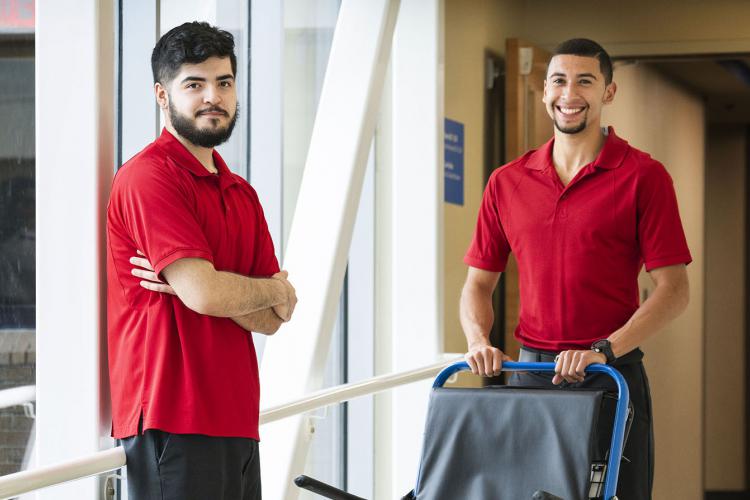
A lot of people are obsessed with their fitness trackers these days.
Some desk workers fret all day about whether they’re on pace to meet their goals for steps or miles covered. But the 20 patient transporters who work at JPS have no such worries.
While the average American adult takes about 5,100 steps every 24 hours, the equivalent of about two and a half miles of walking, it’s not uncommon for one of the red-shirted patient transporters to log more than three times that amount of activity in an average eight-hour shift. When they take a step, they’re not just carrying their headphones and cell phone with them. Transporters are likely to be pushing a 200-pound patient in a wheelchair or in a hospital bed.
Patient transporter Jay Castaneda said he covers 7-8 miles on an average day in the halls at JPS. If things are busy, he’ll log more than 10 miles – or 20,000 paces. That’s twice the 10,000 steps recommended by doctors and groups like Weight Watchers to improve heart health, lose weight and stabilize blood sugar levels, among other benefits. You’ll hear no complaints from Castaneda. He said it’s like getting paid to get in shape.
“Since I started working here about a year ago, I’ve lost 50 pounds from 230 to 180,” said Castaneda “I’ve tried to watch what I eat a little bit better, but the work has definitely made a big difference. When you push a patient in a bed, it’s like doing a bench press while you walk.”
Gabriel Zambrano was already an accomplished distance runner when he came to work at JPS as a patient transporter in February. He made headlines right after he started his new job when he nearly won the first marathon he ever entered – then he dropped to a knee at the end of the race and proposed to his girlfriend. Since then, his stellar running ability has only improved, including his first marathon victory.
“Everybody trains,” Zambrano said. “It’s the extra things you do outside of training that make the difference. And this job gives me a great chance to do a lot of extra miles.”
On many days, Zambrano does 10 miles of running before he comes to work the second shift – and then he does another 7-8 miles of walking after he gets to JPS. Zambrano scoffed when asked if the work was tough to face after a long run, saying it’s important for a marathon runner to learn how to deal with soreness and pain.
“When I am pushing a bed with a patient in it up a ramp I visualize running up a big hill in a race and it helps me with my mental preparation,” Zambrano said. “Before I started working here I was a waiter in a restaurant and, if it was slow, there was a lot of sitting around. Now I am always moving and it makes a big difference.”
Bre’Anna Price said she probably makes 20 trips a day to deliver patients from one area of the JPS campus to another. Common tasks include wheeling a patient to an ultrasound test or to a CT scan. The former is one of the easiest jobs and usually takes only about 15 minutes. The latter requires the transporter to stay with the patient and can take 45 minutes at a time.
“I can tell I’ve definitely gotten stronger and I have more endurance than I did when I started working in patient transport two years ago,” Price said. “Sometimes I’ll be pushing a big bed up a ramp, not even thinking about it, and a nurse or somebody will ask me if I need some help. I tell them ‘I’ve got this.’”
Jade Spencer said the miles just seem add up while the people pushing the chairs are chatting with their riders. It’s a situation that not only makes Spencer’s job more fun. It helps patients, who are sometimes anxious about getting tests or treatment relax and be more comfortable.
Geneva Crow, manager of the Patient Transport and Mail Department, said efficiency is an important quality in a team member. But giving patients the best care possible is always the top priority.
“Every one of our people has to be good at customer service because they spend time one-on-one with the patients,” Crow said. “Sometimes patients want to confide in them, sometimes they just want to vent. Our people have to be able to handle that.”
While some transporters like to be competitive in a good natured way about who goes the farthest or who makes the most trips, they don’t take the competition in the number of steps they take or the miles they cover too seriously.
Price said sometimes patients need a little bit of extra help and that wins out over any thoughts of rushing back to accept the next assignment.
“I try to help patients in the best way that I can,” Price said. “That’s the top priority. Sometimes I have patients ask me to stay with them when they have to talk to the nurse or they just want to talk about what they’re going though. If I can make them feel better by taking a little bit of extra time, that’s the right thing to do.”
